Either you are a personal hair user, or a business owner operating in the hair industry, Yaki hair textures are no longer an unfamiliar concept. Indeed, among the available texture options, Yaki hair has made itself one of the most successful, in-demand hair lines in the market – gathering attention from buyers far and wide. As popular as it is, Yaki hair is still often mistaken for other texture choices and concepts, causing even more confusion among both first-time buyers and experienced clients out there.
Unknowing of what is Yaki hair, its origins, features and variations can lead to much more than just misunderstanding, but can also potentially cause inexperienced hair buyers to be misled by scammers or unreliable vendors. However, by going over this article, readers would be provided with such valuable insights regarding Yaki hair, hence, be able to navigate better in the global, diverse hair market.
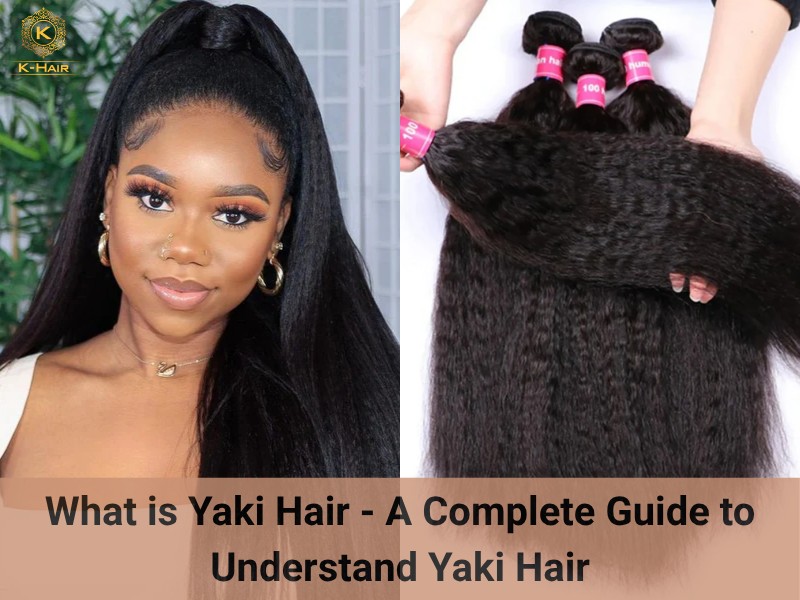
1. What is Yaki hair?
By definition, Yaki hair is a type of hair texture, referring to a specific look, rather than a type of hair like many might assume. Upon first impression, Yaki hair looks a lot like the 4B/4C African American women’s natural hair that has been relaxed or straightened, creating a natural, yet elevated look that satisfies both natural beauty and glam-hair lovers. Upon closer inspection, one might actually observe that Yaki hair, despite how silky or sleek it may seem, always seems to preserve miniature, natural kinky curls or waves in each and every hair strand. Such features help to distinguish it from the natural, sleek straight hair in the market, backing up its uniqueness and popularity, especially among African American hair buyers looking for natural, elegant hair textures for their look.
Despite popular belief, Yaki hair is rarely a newly introduced concept. Indeed, according to the world-renown anthropologist and author Emma Tarlo, the earliest appearance of Yaki hair dates back to decades ago in the Himalayas, seen in the local’s early attempt to mimic the natural texture of African American’s natural hair look, using yak hair as extensions. However, throughout the time, this practice has been dropped by its practitioners, mainly due to the threat of allergy and irritation that comes with using animal fur as cosmetic hair. Nowadays, Yaki hair is mostly made with human hair, or synthetic hair, however, their name “Yaki hair” still takes root in the earlier yak hair use, reflecting its origin in the Himalayas.

2. Where does Yaki hair come from?
To understand what is Yaki hair, we must be able to identify the different hair origins in the market first. Indeed, given the resounding success and profitability of the Yaki hair sector, as well as the entire hair market as a whole, many different regions have jumped into the market, offering their own version of Yaki hair to the global customer base. Each of these suppliers tends to have their own distinct features, manufacture scale and pricing, which will be discussed as follow:
2.1. Vietnamese Yaki hair vendors
For hair buyers looking for a reliable source of Yaki hair to stock for the next sales season, Vietnamese hair suppliers would indeed be a suitable candidate. In fact, among the other competitors in the market, this particular supplier options can provide the best hair quality and authenticity for buyers learning what is Yaki hair:
2.1.1. Vietnamese hair origin
Facing the prominent hair shortage happening in many parts of the world, Vietnamese hair is among the rare supplier options that can still manage to provide the most authentic domestic hair sources in the market. Indeed, the country’s developing economy helps keep the influence from global, modern hair trends at bay, and the traditional beauty standards of women of minorities residing here secure a stable, high-quality, chemical-free raw hair source for production. These features contribute to the abundance of local hair sources of Vietnam, helping vendors to secure the most authentic, guaranteed hair origin for each and every of their orders.
2.1.2. Hair features
Vietnamese hair has always been referred to as the World’s Finest hair – highly praised by hair buyers across the globe for its appearance and functionality. Indeed, the country’s tropical monsoon climate helps to shape the natural features of the hair, while the local’s hair care routine and diet provide the necessary nutrients and moisture for the hair to grow to be as healthy and strong as it is. In terms of physical appearance, Vietnamese Yaki hair is extremely soft, silky, with thick and durable strands that can capture the attention of buyers at first glance. In terms of performance, the hair can be styled to one’s liking: be straightened, curled, and be bleached to as bright as #60 platinum blonde – the brightest hair color out there!
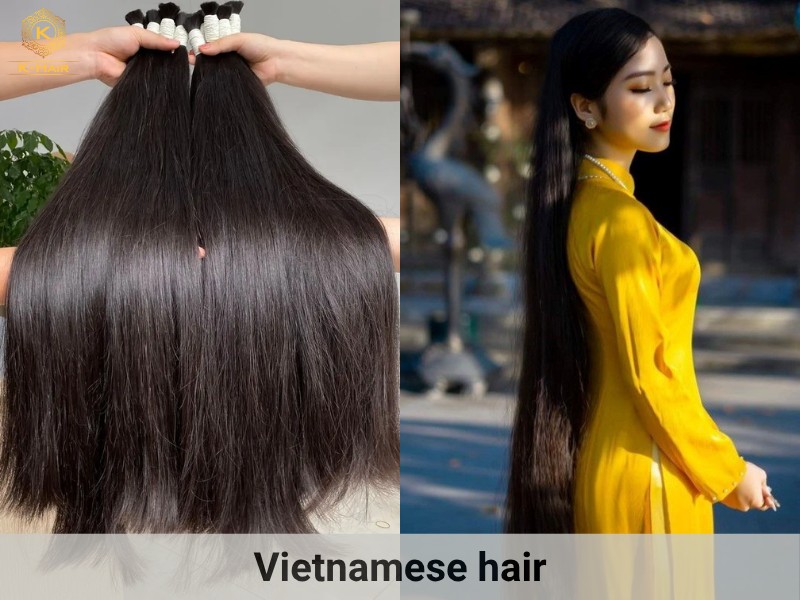
2.1.3. In terms of manufacturing scale
Used to be just raw hair suppliers for Chinese hair vendors, Vietnamese vendors have been able to regain full control over their own local hair source, becoming a manufacturer themselves. With more than 30 years of experience, Vietnamese hair vendors are able to equip themselves with adequate technological advancement and skilled craftsmanship needed to back up their rising hair demands in the market. Furthermore, the Vietnamese hair industry is also evolving, hence, is able to diversify their texture offerings, satisfying the varied hair needs and preferences out there.
2.2. Chinese Yaki hair vendor
Getting to know what is Yaki hair, we must start with one of the biggest, most influential hair supplier options in the market – the Chinese hair empire. Describing it as one of the largest hair manufacturing hubs is rarely an overstatement, given that this specific hair enterprise alone has contributed nearly ¾ of the global hair market. On top of that, with decades of experience functioning in the field, Chinese hair vendors have been able to establish a reliable vendor image, attracting a vast proportion of hair buyers toward their Yaki hair products.
2.2.1. In terms of hair origin
China is home to one of the most rapidly growing economies on the planet, so undoubtedly, their population is also more subjected to globalization, leading to an increasing relevance of global hair sensations such as bleached, colored hair. Such shifts toward global hair trends also led to a decline in their domestic hair supply, resulting in most Chinese hair suppliers having to source their hair from other regions. Therefore, for most Chinese hair products available in the market right now, most of them tend to be sourced from many different sources, rather than being authentic Chinese hair themselves.
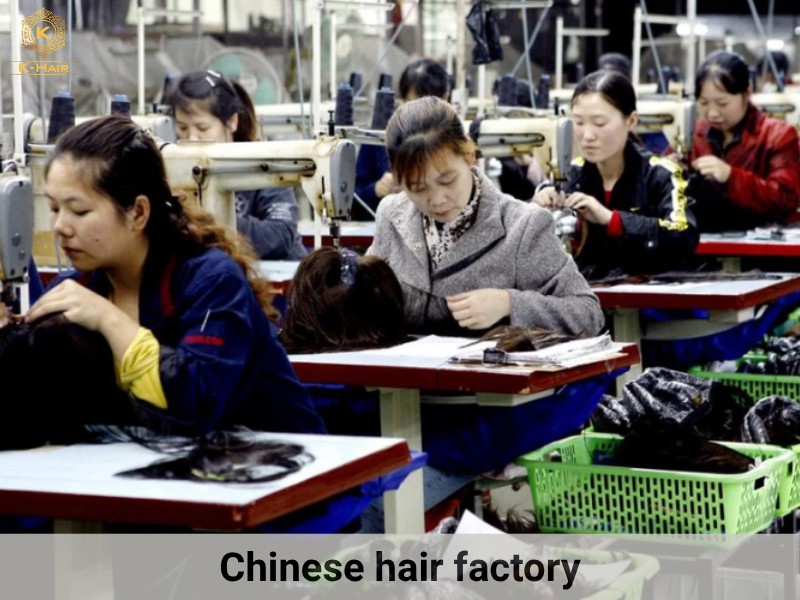
2.2.2. In terms of hair features
One noticeable result of their mixed hair sourcing method is that their Yaki hair products, as well as their hair items in general, tend to have mixed qualities. Indeed, being collected from multiple sources also means that the hair would inevitably lack consistency for different batches, leading to varied quality from one order to another. Furthermore, as they often outsource their hair, Chinese hair vendors cannot guarantee the authenticity of the raw hair materials, as well as ensuring its pristine, optimal quality during the lengthy transportation process.
2.2.3. In terms of manufacturing scale
One major perk of the Chinese hair industry is its impressive output volume and product diversity. Indeed, having decades of experience, alongside with the country’s technological advancement, Chinese suppliers have soon integrated innovative, hi-tech machinery to their hair production, hence, are able to boost their productivity and scale → enhance their product availability and final unit pricing. Furthermore, thanks to their technological advancement, Chinese hair manufacturers are also able to diversify their offerings, including more texture variations and color options for their Yaki product line.
In today’s world, Chinese hair vendors’ reputation has somewhat been tarnished by the increasing number of scammers and unreliable merchants within their own community. Therefore, when working with a Chinese hair supplier, buyers learning what is Yaki hair must also be extra careful of the underlying threat, and verify the vendor’s legitimacy before committing to the final payment.
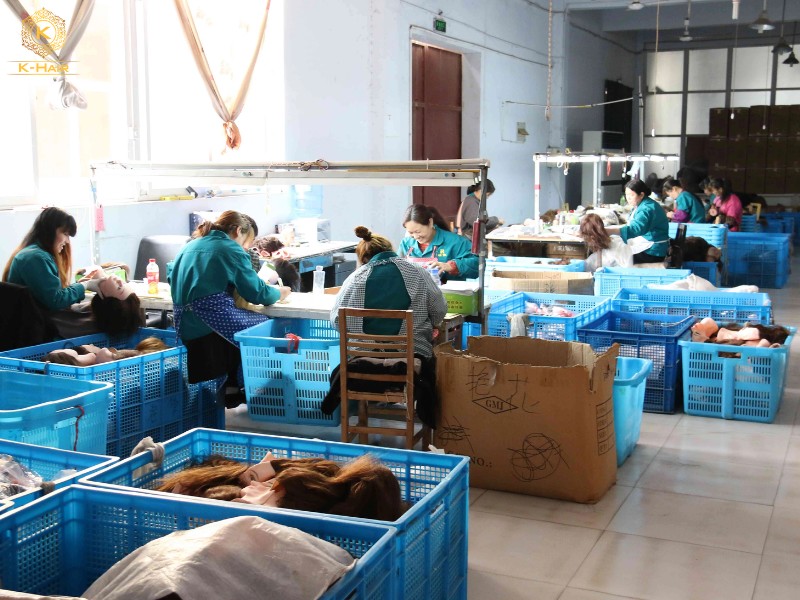
2.3. Indian Yaki hair vendor
In the market, India is home to one of the largest hair industries in terms of availability. Indeed, possessing such impressive hair abundance, Indian hair vendors are able to provide a stable, reliable resources and hair stock to support hair businesses and retailers in the industry, even providing raw hair materials for other hair manufacturers in China and becoming their main hair source.
2.3.1. In terms of Indian hair origin
as previously mentioned, India takes great pride in being one of the biggest hair suppliers in the market. Indeed, thanks to their crowded population and developing economy, India can provide its hair vendors an abundant domestic hair supply needed for production, creating a strong foundation for industry growth and export volume. To make full use of their local rich hair source, hair vendors often source the hair in two main ways:
- Temple hair: much like its name, this sourcing method mostly collects hair from temple-goers, who will cut and donate their hair as an offering to the temple to exchange for good luck. Hair collected by this method also tends to be of decent quality and makes up the most of the high-quality Indian hair in the market.
- Hair balls: Indian hair collectors also fully exploit their local source by collecting tangled, messed-up hair – hair balls, from unsanitary places such as salon floor, trash, public bathrooms,… Given such sourcing methods, most of the hair produced from hair balls are low-quality, heavily damaged products, extremely unsuitable for long-term hair use.
2.3.2. In terms of Indian hair features
The signature features of Indian hair are often decided by the country’s dry climate, as well as the local’s genetics and traditional diet. Hence, natural Indian women’s hair tend to be coarse, thin, weak, with natural curls and black/brown colors, extremely fragile and unsuitable for further styling and texturizing. Therefore, during production, many hair vendors intervene and use chemicals to further strengthen the hair and make it suitable for market consumption. As a result, despite the initial lustrous, healthy appeal, Indian hair has been reported by its customers to quickly wear off over time, once the coating fades away.
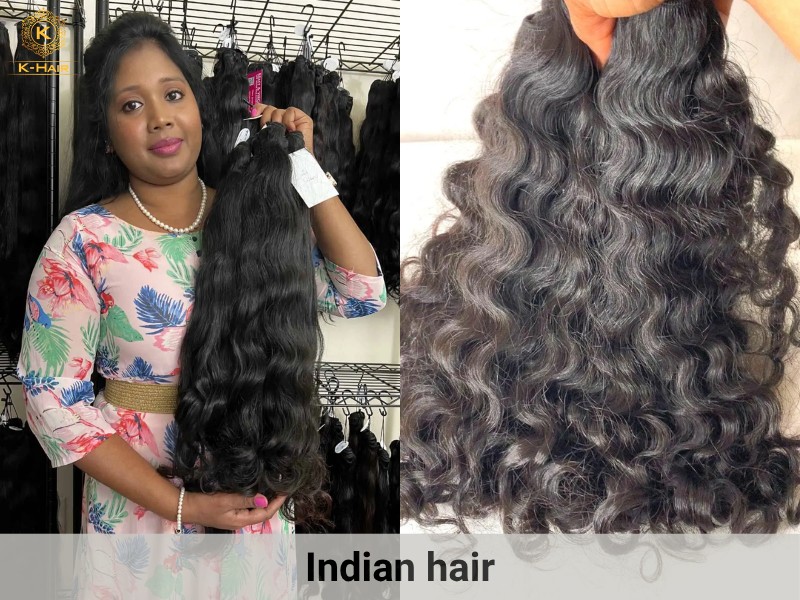
2.3.3. In terms of manufacturing scale
Influenced by the country’s developing economy, Indian hair vendors function mostly in small-scale, household factories, adopting obsolete technologies and manual labour for their hair production only. Hence, comparing manufacturing scale, Indian hair vendors would most definitely fall behind other competitors in the market. Furthermore, as they rely mostly on manual labour as their main workforce, Indian hair vendors cannot provide diverse, trendy Yaki hair textures without using the old-fashioned, damaging chemical method – limiting their diversity and affecting their overall hair quality and longevity.
2.4. Brazilian Yaki hair vendors
Another emerging hair origin in the market that all hair buyers learning what is Yaki hair must be aware of is the Brazilian Yaki hair – offering a fresh, exotic hair source compared to the other popular and universal Asian hair origin in the market. Before teaming up with a Brazilian hair vendors, it is necessary for buyers to grasp some of the basic information regarding this specific vendor option:
- In terms of hair origin: over the years, Brazilian hair has been considered as one of the most sought-after hair lines in the market, as many assume that hair collected from the sensual, dynamic and lively Brazilian women would be as strong and resilient as such. However, despite popular belief, most Brazilian hair is not initially sourced from Brazilian women due to low demands. To provide supply for such rising demands for Brazilian hair, local vendors often have to resort to collecting hair from other countries to make up for their shortage. Hence, much like Chinese hair, Brazilian hair also consists of mixed hair sources.
- In terms of hair features: being sourced from multiple supplies, Brazilian, much like Chinese hair, tends to lack consistency and uniform quality for different batches. However, to mimic the natural appeal of Brazilian hair, many hair vendors often use chemical-based solutions to treat and process the hair. As a result, despite being outsourced from elsewhere, most Brazilian hair extensions and other related products we see today look almost identical to natural local women’s hair: thick, bouncy, coarse strands, with natural, bubbly curls.
- In terms of manufacturing scale: the Brazilian hair industry is still a relatively new one, hence, most local hair vendors function in small-to-medium scale factories, with adequate technological application needed to provide a stable output volume for international trading. However, instead of providing diverse textures and color options, they pay more attention to tailoring their natural hair textures only, hence, limiting their offering’s diversity.
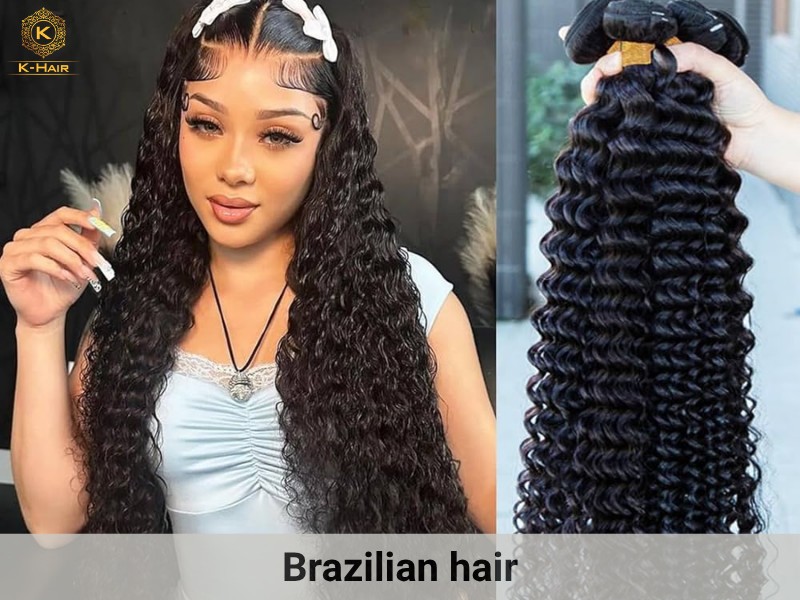
3. What are the hair types for Yaki texture?
The next step in learning what is Yaki hair is getting to know the different hair quality and hair types that make up this iconic hair texture. Indeed, given the different hair preferences and pricing range in the market, hair manufacturers have diversified their offerings into different hair types to better cater to the varied hair needs from different market sectors. The existing hair types for Yaki hair might include the following:
3.1. Virgin Yaki hair
Virgin hair is often considered the highest hair quality in the market, hence, also tends to have stricter sourcing requirements and higher pricing models. In fact, to be considered Virgin, the hair must be sourced from one healthy, young donor only, whose hair must be completely chemical-free prior to the sourcing and production. Thanks to such high sourcing standards, all hair collected is of much higher-quality than the other hair types, guaranteeing ultimate cuticle alignment and pristine untouched quality for each and every hair strands gathered. Therefore, Virgin hair can offer both appealing outlook and innate quality: soft, silky, smooth strands that are able to be straightened, curled, and be bleached to as bright as #613 or #60.
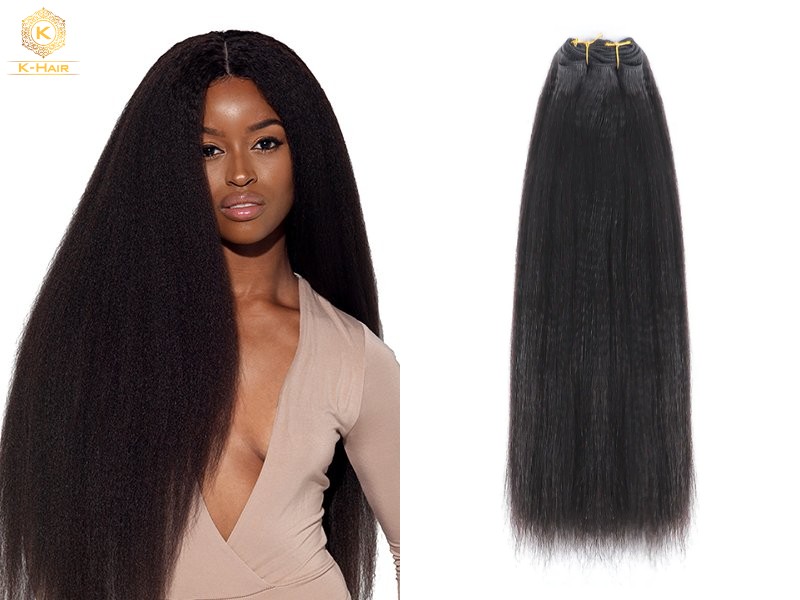
3.2. Remy Yaki hair
Compared to Virgin hair, Remy Yaki hair is a much more economical option. Unlike its Virgin counterparts, Remy hair can be collected from 2-3 donors, whose hair must also be completely free from any prior chemical involvement. This allows Remy hair to widen its availability and raw hair source, while still maintaining pristine, chemical-free hair strands for long-term hair use. However, being collected from several heads also means that Remy hair cannot guarantee the same level of cuticle uniformity as Virgin hair, making the hair slightly more prone to tangling and shedding, and demanding more frequent maintenance. Nevertheless, in the hands of stylist, Remy hair can still be bleached to warm colors, such as #27 honey blonde, and be styled freely without taking serious damage.
Learning about what is Yaki hair, readers must know that beside the above decent-quality hair types, also exists other low-quality options, such as:
3.3. Non-remy Yaki hair
This is the lowest quality of human hair there is. Non-remy hair, unlike other human hair options, is collected from multiple, unidentifiable sources, mostly consists of fallout, trashed hair in unsanitized, unhygienic locations, such as garbage, salon floor, public bathroom – similar to Indian’s hair balls mentioned above. As the hair strands are collected from multiple heads, there are high chances that most of them have been previously tampered or tarnished with chemicals or other harmful substances. Furthermore, to create market-qualified hair products out of them, hair manufacturers would have to chemically treat and process the hair to make their cuticles aligned and elevate its smoothness and silkiness. However, such a method can rarely improve the hair user’s experience, rather, further deteriorate the innate quality of the hair.
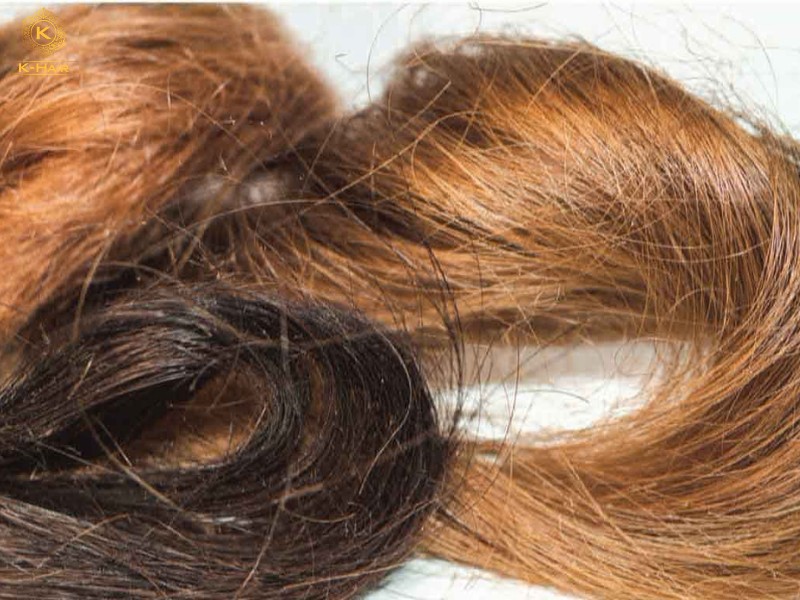
3.4. Synthetic Yaki hair
Unlike the above hair types, Synthetic hair is entirely non-human, meaning that the hair is made of plastic fiber – being designed to mimic the natural hair shine and appeal of authentic human hair. Despite its elevated luster, upon close inspection, the hair’s brittle, coarse strands can easily give it away, making the overall hair look cheap, awkward and aesthetically unappealing. Furthermore, as the chemical-based materials are extremely heat-sensitive, hence, it cannot take on high-heat styling, as the strands can melt or break if they come into close contact with the heat from styling tools. On top of that, synthetic hair cannot absorb the chemicals from hair bleach, making it impossible to bleach and customize the hair.
4. What are the types of Yaki textures in the market?
Nowadays, given the prominent market presence of Yaki hair and cosmetic hair solution in general, customers are consciously looking for something new, exotic and original, rather than the traditional, classic Yaki textures. To catch up with such market demands, more and more hair manufacturers have diversified their classic Yaki hair into different variations, each with their own signature looks. Getting to know what is Yaki hair, clients must be able to grasp the differences between these variations, as well as deciding which texture is best suited for their buying purposes.
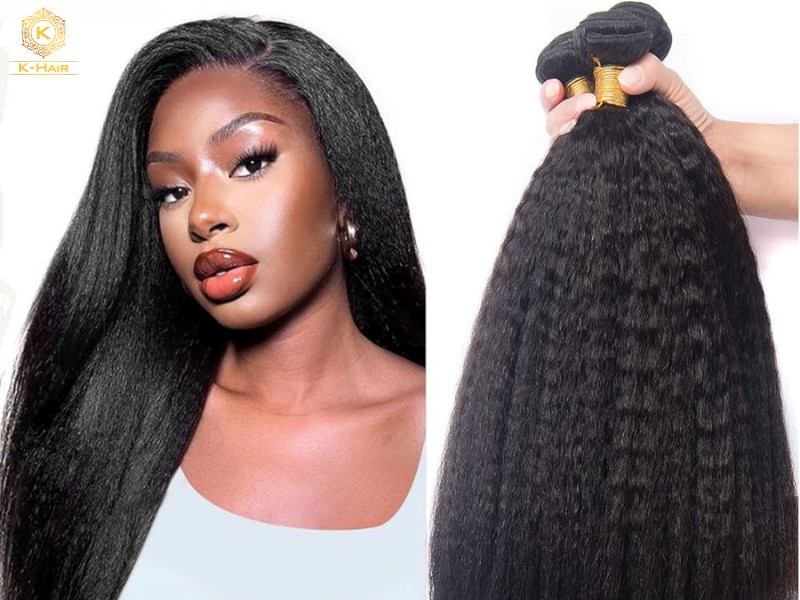
4.1. Silky Yaki
Among the four, Silky Yaki is the smoothless, most elegant hair texture, extremely suitable for buyers looking for a natural, silky hair look that is also able to mimic the Afro-textured relaxed hairstyles.
Upon first impression, Silky Yaki can easily be mistaken with the popular Silky Straight textures – a prominent mistake for many first-time buyers out there. However, under close inspection, the buyers can actually observe that integrated in each strand are the minimal micro-kinks, rather than the ultra smooth surface seen in Silky Straight textures.
Furthermore, one signature feature of the Silky Yaki is its hair shine. Unlike the glossy, radiant hair shine seen in Silky Straight, Silky Yaki, thanks to its micro-kinks, are able to evenly reflect and distribute light, creating a natural, elegant yet eye-catching shine, making it highly exotic and unique compared to other Yaki variations. On top of that, among the four variations, Silky Yaki is also the softest, most light-weight one – suitable for clients looking for fine, relaxed and sleek hair extension solutions for their hair look.

4.2. Regular Yaki
Compared to Silky Yaki, Regular Yaki tends to be superior in terms of volume and thickness, hence, is often among the safest texture variations, offering both natural look and impressive fullness to the final look.
Not to be mistaken with Silky Yaki, Regular Yaki often comes with more visible, moderate micro-kinks that mimic the look of a natural African American hairstyle after light straightening. As a result, Regular Yaki texture tends to provide more volume and natural thickness, delivering a more bubbly, bouncy look to the hair. Much like Silky Yaki, Regular Yaki can evenly reflect and distribute light, creating a dim yet elegant hair luster. However, as the micro-kinks are relatively more visible, hence, Regular Yaki can appear more natural, textured and laid-back compared to the Silky Yaki.
As for its moderate kinky curls integrated, Regular Yaki and its hair strands are often coarser and thicker, too.

4.3. Kinky Yaki
Kinky Yaki, or also known as Kinky Straight, is among the most well-known and sought after variations of the Yaki textures. The reasons are simple, because Kinky Yaki can offer the most thickness and volume to the hair look, while still maintaining its straight textures – mimicking the iconic look of Afro-textured hair after blow-drying.
Compared to the above texture variations, Kinky Yaki comes with the most defined, dense and visible micro-kinks, hence, leading to more volume and thickness. Furthermore, as more kinky curls are integrated in each strand, Kinky Yaki can also be fluffier, thicker, and much more voluminous than the traditional Yaki, while still maintaining a straight, relaxed and blow-dried look that helps to deliver more confidence in every movement.
Among the four variations, Kinky Straight can offer the most fullness to the clients’ hair look, while still appearing straightened, natural and relaxed to seamlessly blend into one’s own hair, adding volume without looking awkward or unnatural.
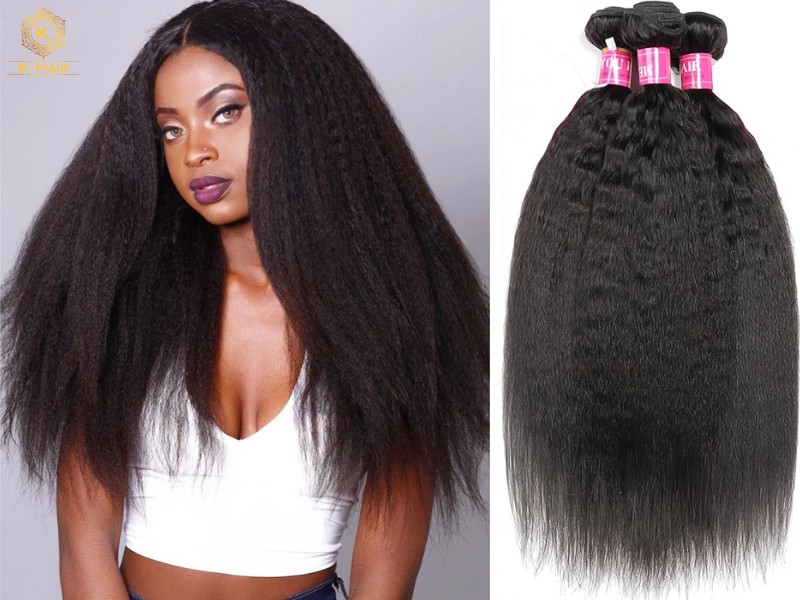
Read More: Kinky Curly Human Hair Bulk – The HOTTEST Hair Item in 2026!
4.4. Coarse Yaki
Unlike other Yaki variations, Coarse Yaki is the most voluminous hair texture, with extremely defined curls that make it look almost identical to the natural kinky curly hair look of African American women.
Coarse Yaki is undoubtedly the thickness, and most robust Yaki texture out there, with highly defined, dense and tight micro-kinks that best mimic the iconic Afro hairstyles seen in many natural African women’s hair, rather than looking like their relaxed hair look like the other variations. Thanks to its signature textures, Coarse Yaki also appears thicker, applying maximum volume and a highly textured look for its users. However, due to its defined curls and coarse strands, Coarse Yaki can only offer a limited styling range compared to other Yaki types, making it only suitable to use as it is.
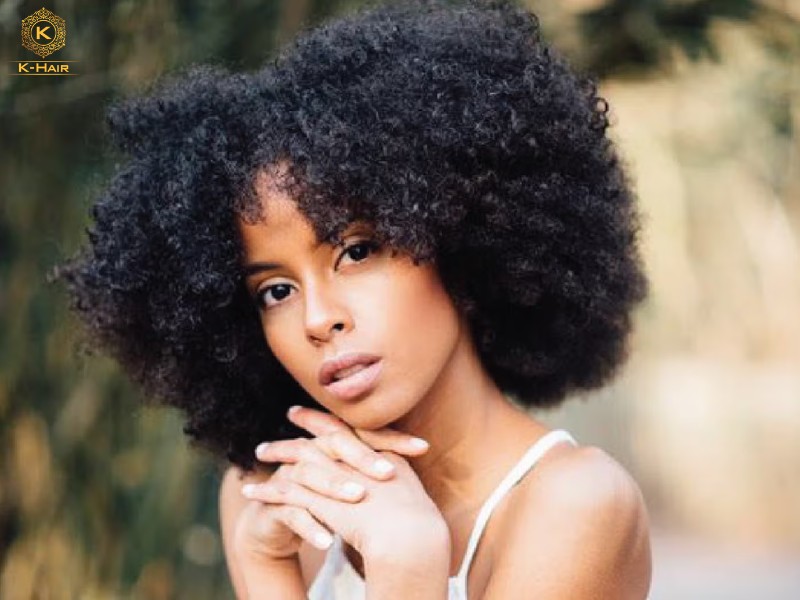
5. How To Style Yaki Hairstyles?
Learning what is Yaki hair is rarely enough. Indeed, for end-users out there, to truly make full use of a hair, as well as elevate your natural appearance, one should also learn how to style Yaki hair the right way, so as not to affect its longevity while still achieving your desired look:
5.1. Heat styling
One of the most popular styling options that Yaki hair can allow is heat styling: using heat-induced professional tools to straighten, curl, texturize the hair. For this particular styling method, or any other methods, it is best to start with small sections of the hair, and style them one by one, rather than going over big clumps of hair at one. It is also worth noting that, even though human hair can allow much more versatile styling options, hair users are highly suggested to spray a light layer of heat protectant first, and use moderate temperature, from 300-350°F only, to avoid any internal damage or dehydration. Typically, for high-quality human hair, the styling effect would last from 3-4 hours – much like our own hair.
5.2. Coloring
Bleaching Yaki hair is always feasible, given that the hair is made entirely from human hair. However for a pre-processes, texturized hair texture as the Yaki, the bleaching process might also come with many cautions. For example, the chemicals involved in the process might inherently cause dehydration and damaged cuticles, leading to more fragility and breakage, which can potentially cause the overall lifespan of the Yaki hair to decrease even further. Hence, before committing to bleaching the hair, it is best to seek consultation from a professional, or better yet, schedule a salon visit or ask the hair supplier to bleach the hair themselves.
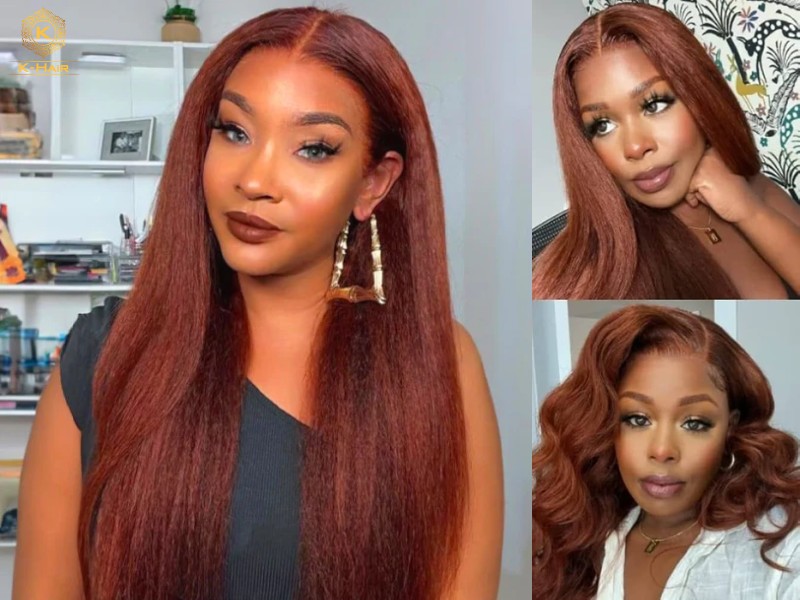
5.3. Non-heat styling
For hair users wanting styling methods that do not come at the cost of the wellbeing of the Yaki hair, you can also take references from the following non-heat, chemical-free styling options:
- Braiding: to achieve natural, effortless curls, you can also dampen and braid or twist the hair into sections, leaving it overnight and unraveling the braids in the morning.
- Fabric curling: another way to achieve natural, loose curls is to use the fabric curling method – twisting the hair around a silk or satin strip, securing the twists and leaving it to sit overnight. In the next morning, you would already have a loose wavy texture ready for the day.
- Bantu knots: another way of non-heat styling that requires only a few tools is the Bantu knot, in which the hair would be twisted into small knots, and secured by plastic bands to sit overnight or to dry. Once finished, the hair would be texturized with natural waves and volume.
6. How long do Yaki hair extensions last?
When learning what is Yaki hair, one feature that all hair buyers, both end-users and hair business owners must understand is that the longevity of the Yaki hair has a lot to do with the hair types used to make the extensions.
As experts in the field, we have been able to gather enough information regarding different hair types and their lifespan, presented in the table below:
| Yaki hair extensions | Lifespan |
| Virgin hair | Being the highest hair quality in the market, Virgin hair would also come with the most long-standing hair use: → Lasting for more than 4 years under proper care. |
| Remy hair | Another long-lasting Yaki hair type is the Remy hair. Although not as long-lasting as Virgin hair, Remy hair is still a suitable long-term hair type: → Lasting from 2-3 years or more under proper care |
| Non-remy hair | Being the lowest quality of human hair, Non-remy hair can only be used for a temporary time:
→ Lasting less than 5 months, even under proper care → Need more frequent replacement |
| Synthetic hair | Being made entirely with plastic fibers, Synthetic hair, much like Non-remy, is also short-lasting:
→ Lasting less than 6 months, even under proper care → Need more frequent replacement |
Furthermore, hair users might also need to note that, besides the nature of the hair types, other factors also have their own impact on the longevity of the hair. For example, frequent styling might subject the hair to dehydration and damage, while frequent hair use might expose the hair to other harmful external factors such as humidity, sunlights,… Hence, beside selecting the best hair types for your products, buyers also need to consider other aspects and go out of one’s way to maximize the lifespan of the Yaki hair.
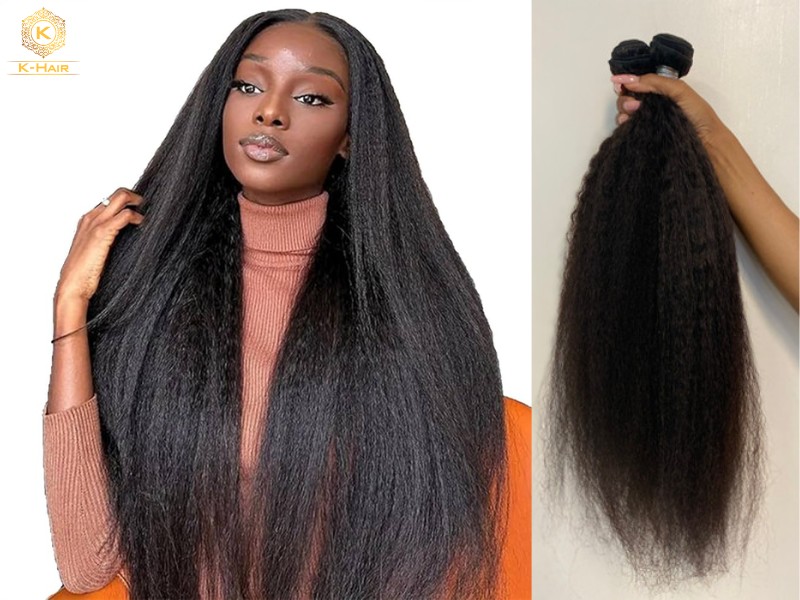
Read More: How Long do Hair Extensions Last? Hair Extensions & Their Lifespan
7. How to take care of Yaki hair extensions
Looking for a way to further boost the lifespan of your Yaki hair extensions? This part will provide all the answers you need, as well as tips and advice you might need throughout the maintenance of the products. This routine is also one of the must-haves for hair buyers learning what is Yaki hair:
7.1. Swimming & Sun exposure
One notable reminder is that constant contact with direct sunlight and chlorinated water can significantly shorten the lifespan of Yaki hair extensions. Given that Yaki textures are designed to mimic the look and feel of straightened or relaxed hair, excessive dryness can negatively affect their smooth, natural finish, making the hair look dull and lifeless over time. To minimize such damage, hair users can adopt a few extra protection steps: limit prolonged Sun exposure by using a hat or umbrella; wear a swim cap to keep pool water away from the hair; and wet the hair with clean water before entering the pool or salt water. These small habits help shield the Yaki texture from dehydration, allowing the hair to retain its softness, shape, and overall healthy appearance for a longer time period.
7.2. Styling tips
High-heat styling remains one of the biggest threats to Yaki hair extensions. Excessive heat can alter the Yaki texture, cause dryness, and weaken the cuticles over time. Therefore, applying a heat protectant is a must before any heat styling. Additionally, daily heat styling is discouraged to preserve the smooth, blowout-like finish that Yaki hair is known for.
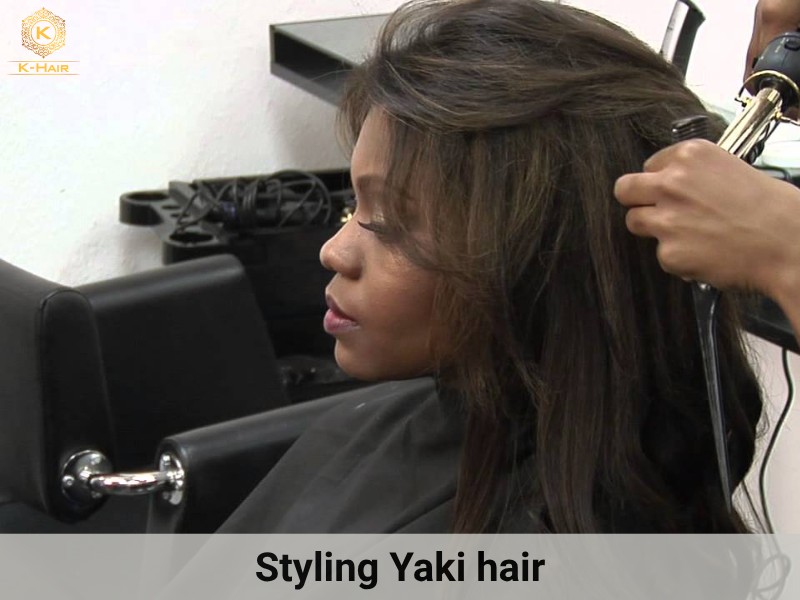
7.3. Brushing & Detangling
Maintaining a tangle-free texture is essential, especially for Yaki hair, as its slightly coarse, natural-pressed texture can accumulate knots if neglected, while built-up tangles can lead to severe hair shedding, or even leading to cutting the entire tangled section off – making the hair look uneven and unappealing. To avoid this, clients should adopt the correct brushing method: use a soft-bristle brush or an extension-friendly detangling tool; start brushing from the ends to the root; avoid pulling or using excessive force; and always detangle before washing. These simple techniques help maintain the smooth, manageable feel of Yaki hair while minimizing potential breakage.
7.4. Washing
Washing Yaki extensions also requires extra attention, as many harsh hair-care products can strip moisture and affect the natural pressed texture of the hair. Therefore, when choosing shampoos and conditioners, clients should ensure the products are sulfate-free and gentle on extensions. It is also advisable to wash the hair 2-3 times per week only, to prevent the loss of natural oils that help maintain softness; apply conditioner only from mid-lengths to ends, avoiding the roots and attachment areas; and rinse thoroughly to remove all residue and buildup.
8. Trendy hairstyle with Yaki hair
Knowing what is Yaki hair, you would soon realize that, Yaki hair by itself is gorgeous, hence, users do not have to spend too much effort in perfecting the hair to make it beautiful. However, if you are getting tired of wearing Yaki hair as it is, here below are some predicted hairstyles that will soon become popular in 2026 – some references for your next styling section:
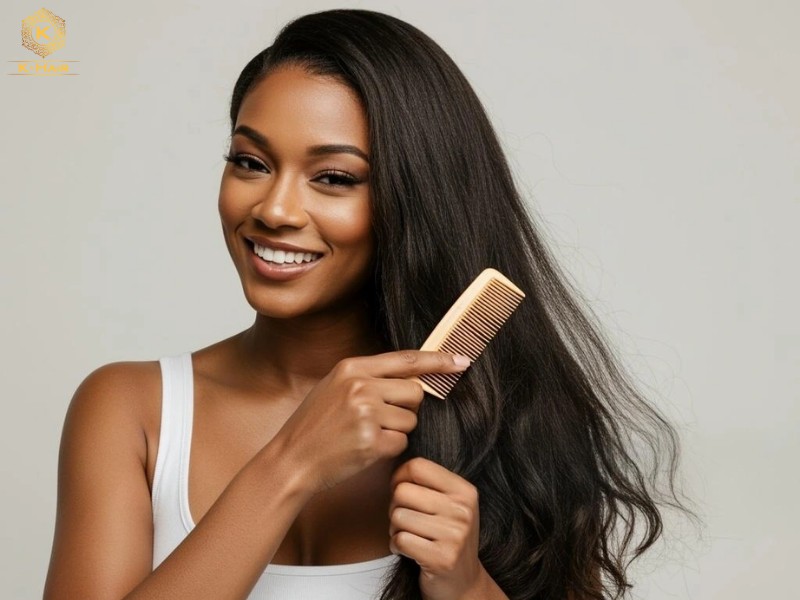
8.1. Sleek High Ponytail
With the current frenzy toward sleek, elegant and glamorous hair looks, further promoted by celebrities such as Ariana Grande, Kim Kardashian,… this sleek high ponytail is predicted to be the best selling service for many hair stylists out there in 2026.
To create this flawless, lustrous hair look, the Yaki hair itself will be applied with gel to create a flat, neat look, providing a base for the ponytail. The ponytail is often positioned at the top head area, creating a voluminous, bouncy look – contrasting the sleek appeal of its base.
To recreate such an iconic look, a lot of gel would be used, hence, the Sleek High Ponytail is best suited for Silky Yaki only. In fact, thanks to the hair’s soft, lightweight strands, when applied with the product, the hair would be able to maintain the final effect of the gel for a much longer time. Furthermore, its sleek, silky look is also best suited for the final look of the ponytail.
8.2. Protective Braided Styles
Another iconic hair look that can be done with Yaki hair is the classic Protective Braids – one of the culturally-significant, traditional looks of African American women. In fact, applying the protective braid, much like its name, hair users can help to protect their natural hair from the external harmful factors such as high humidity and high heat, ventilating and concealing the sensitive scalp. Furthermore, this style is also extremely suitable for wearers with an active lifestyle, creating a stiff, unmovable hair look that stays put even in vigorous activities.
For the Protective Braided styles, the hair would be braided into box braids, cornrows, or twists, or customized freely to represent one’s personality and aesthetic preferences.
Unknowing by many, but Yaki hair is among the best candidates for braiding, as for its texturized look, the hair can provide a firmer grip to the braids, hence further enhancing the lifespan of the protective styles. To achieve the maximal effect for the style, it is best to use Coarse or Kinky Straight Yaki, as these two Yaki variations can not only blend in better with the natural hair of the African women, but also provide a better grip during installation.
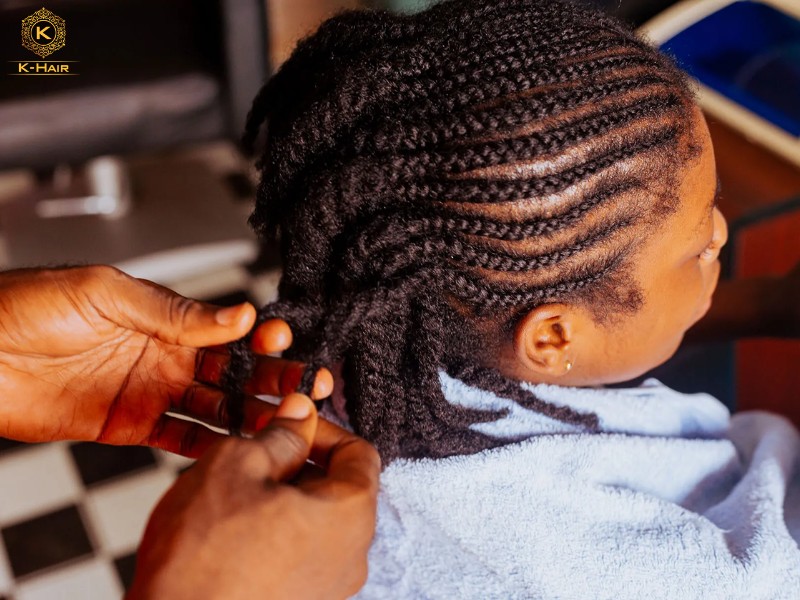
8.3. Accessorized Styles
To step up your hair game, instead of resorting to elaborated hairstyles, you can simply use jewelry or hair accessories. In fact, by using these add-ons, you can not only add more detailing to the simple Yaki hair, but also customize your appearance to match your personality and aesthetic preferences.
To achieve this style is simple, you can use a wide range of hair accessories and jewelry, such as headbands, hair clips, ribbons, or braiding beads,… and use them on multiple options of hairstyles, such as buns, afros, ponytails,…
For this hairstyle, any type of Yaki hair can be used – as long as it aligns with your preferences and aesthetics.
8.4. Half-Up, Half-Down Styles
If you want the sleek look of the ponytail, but do not want to apply as many products or create as much pressure on the hair, this is your go-to style. Indeed, the Half-up Half-down when applied to the user’s hair, can combine both the convenience of the updo, with the sleek, voluminous look of the Ponytail.
To achieve this look, much like its name, the top proportion of the hair will be sectioned out and tied into a ponytail, with its base applied with gel to get the same sleek look of the High Ponytail. Unlike the top part, the bottom portion will be left down freely, creating an optic illusion of having more volume and thickness to the hair than its actual look.
Due to its similarity with the High Ponytail, the Half-up, Half-down also works best with the Silky Yaki. For a variation where no gel is included, Regular Yaki is the best as it applies more volume for such cases.
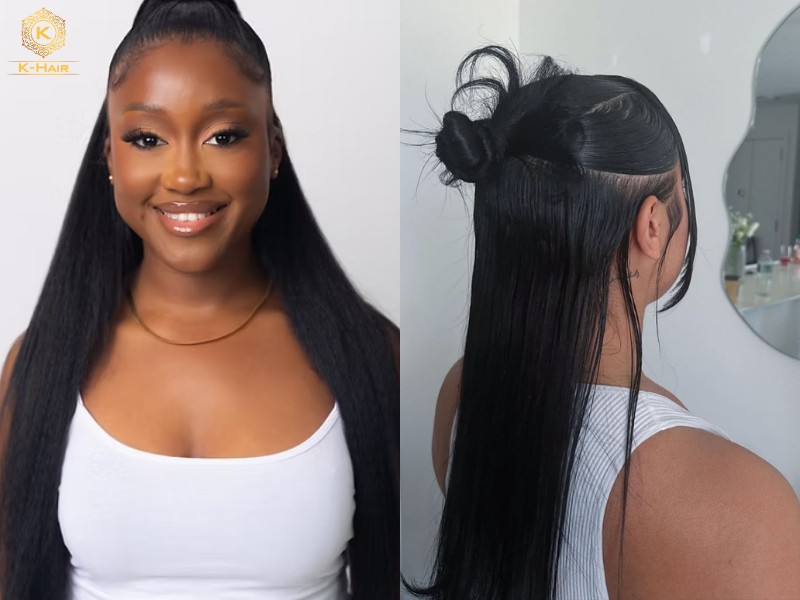
8.5. Classic Kinky Yaki Afro
For hair users with a busy lifestyle, wanting a more convenient, ready-to-use hairstyle, the Classic Kinky Yaki Afro should be the perfect candidate. Indeed, wearing the hair as it is can save the users with much time spent on styling, while still offering a voluminous, natural and unique look – traits that make the Afro one of the trending hair items in 2026!
To achieve this style, you would simply let the hair float freely, maintaining its natural texture without adding any product or styling tools. By doing so, you can benefit from a fluffy, bubbly and voluminous look, without even trying!
Any Yaki hair variation can be used to achieve this look. However, for the best final effect, it is highly recommended for hair users to resort to thicker, fuller texture options, such as the Coarse, Kinky Straight Yaki, to achieve the classic Afro look.
9. Who is the Yaki hairstyle suitable for?
Getting to know what is Yaki hair, customers should also consider its suitability before committing to purchases. Indeed, for hair businesses, targeting the right audience and securing the most profit for one’s hair brands, while for end-users, purchasing the right hair textures can help to further elevate their natural look, instead of contrasting with it. Yaki hair, much like any other hair textures in the market, tends to have its own target audience and market:
9.1. Natural beauty lovers
Yaki hair is the perfect identical twin to natural kinky, coily hair of African American hairstyle, hence it can offer the most natural-looking, effortless hair look that many desire. Especially for patients of hair loss, thinning, balding hair line, looking for a suitable hair solution that can help to mitigate their hair issues while maintaining and delivering a natural, seamless appeal. Furthermore, for hair lovers wanting to take a break from the trendy, elaborated and fashion-forward textures, and get in touch with their natural beauty and original, untouched look, Yaki hair provides a suitable solution, helping hair users to stay connected to their traditional Afro-textured hairstyle.
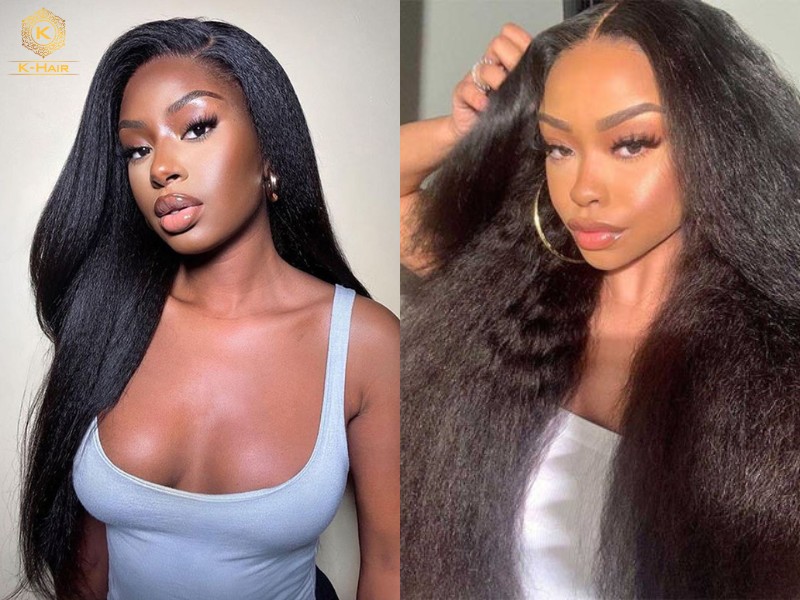
9.2. Protective hairstyle
As previously mentioned, Yaki hairstyle is the perfect ingredient, entrusted by many professional hair braiders and salon stylists across the globe, mainly for its suitability as a braiding hair. Indeed, given its integrated kinks and natural textures, Yaki hair can blend seamlessly into its user’s hair textures, as well as providing a firm grip for the braid to last longer and become more durable during the braiding process. Hence, if you plan to marketize this specific product, make sure to aim for salon professionals or hair braiders, as these customer bases tend to have higher demands for Yaki hair.
9.3. Elevate hair look
Not only is it natural, but many Yaki variations can also deliver a sense of thickness and glamour to the person’s appeal. Indeed, for everyday hair use or for formal gatherings, Yaki hair can offer its wearers with the natural volume, relaxed yet still sophisticated hair look needed for every occasion. Given the current market shift toward voluminous, thick and fluffy hair, Yaki hair is estimated to be one of the newest hair trends in the next sales seasons, catering to a wide customer base worldwide.
9.4. Specific market region
Thanks to its signature look, Yaki hair is among the most popular hair textures used by African American women across the globe. Its main markets are mostly regions with a high proportion of this specific demographic, such as in the United States, in African countries, South American and European countries. For business owners, these are the markets that you should aim for to secure the most profit for your business.

10. K-Hair: #1 Vietnamese human hair extensions
After getting to know what is Yaki hair, hair buyers should now be ready to explore the numerous supplier options of this specific hair texture. Among their competitors, K-Hair Factory has long positioned itself as one of Vietnam’s most reputable and well-established hair manufacturers, earning strong trust from wholesale buyers worldwide for its premium-quality Vietnamese hair exensions. Over the years, the brand has established for itself a solid reputation built on consistent quality, transparent processes, and a professional working approach that prioritizes long-term reliability in every partnership.
- Among the wide range of hair suppliers available on the market today, K-Hair continues to stand out as a dependable and highly trusted source, particularly recognized for providing 100% Vietnamese human hair known for its natural shine, softness, and impressive durability. Each bundle is ethically collected from healthy Vietnamese donors and processed with minimal chemical involvement, ensuring the hair maintains its original strength, flexibility, and natural texture.
- Hair quality: every K-Hair wholesale wig is designed to allow for bleaching, dyeing, and various restyling techniques with minimal shedding or tangling, which has helped the factory win strong preference among countless international clients. Additionally, the factory offers a wide variety of color choices, from natural black to bright, fashion-forward shades like blonde, orange, and green, making it an ideal destination for buyers seeking both reliability and customization.
- Thanks to its fully in-house production, from raw hair collection all the way to final processing, K-Hair upholds strict quality control standards while removing unnecessary intermediaries. This not only guarantees product consistency but also allows the brand to offer competitive, factory-direct wholesale pricing, enabling clients to maximize profits without sacrificing quality.
- Beyond exceptional hair quality, K-Hair is also widely appreciated for its customer-centered service. With clear communication, flexible payment options, and responsive support across consultation, production updates, shipping, and after-sales care, the factory ensures a smooth, transparent, and reassuring buying experience for all wholesale partners.
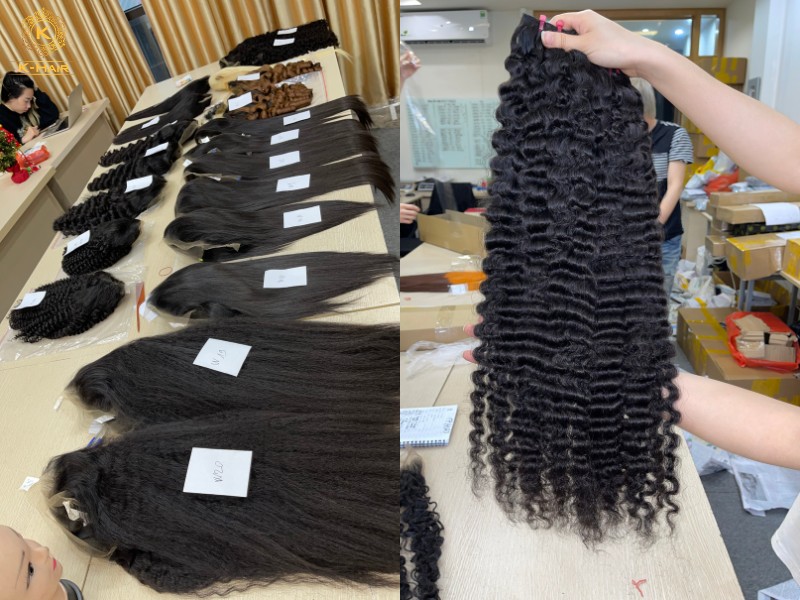
Contact For More Information:
- Website: https://khairvn.com/
- Address: 10A, 171 Nguyen Ngoc Vu, Yen Hoa, Hanoi, Vietnam
- Phone: +8492 633 2545 (WhatsApp)
- Email: [email protected]
- Facebook: https://www.facebook.com/KHairFactoryVN/
- Youtube: https://www.youtube.com/c/KHAIRFACTORYBESTVIETNAMHAIR
- Whatsapp: +8492 633 2545
11. Conclusion
With the information provided in this article, we hope that we have managed to assist young, ambitious business women in the hair industry about the overall market, tips, and most importantly, what is Yaki hair. Doing business requires long-term commitment and support from trustworthy business partners, we proudly present ourselves not only as a trusted hair supplier, but also a supportive friend who will always have your back in this competitive industry.

